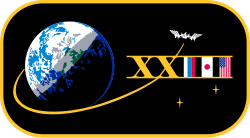Expedition 24
| Expedition 24 | |||
 | |||
| Uppdragsstatistik | |||
|---|---|---|---|
| Rymdstation: | ISS | ||
| Start: | 1 juni 2010, 00:04 UTC[1] | ||
| Slut: | 25 september 2010, 02:02 UTC[1] | ||
| Antal besättningsmedlemmar: | 6 st | ||
| Rymdpromenad | |||
| Antal rymdpromenader: | 4st | ||
| Total tid: | 29 tim 31 min | ||
| Transport | |||
| Uppskjutning: | med Sojuz TMA-18, Sojuz TMA-19 | ||
| Uppskjutningsplats: | Kosmodromen i Bajkonur | ||
| Landning: | med Sojuz TMA-18, Sojuz TMA-19 | ||
| Landningsplats: | Kazakstan | ||
| Kronologi | |||
| |||

Expedition 24 var den 24:e expeditionen till Internationella rymdstationen (ISS). Expeditionen började den 1 juni 2010 då delar av Expedition 23s besättning återvände till jorden med Sojuz TMA-17.
Fjodor Jurtjichin, Shannon Walker och Douglas H. Wheelock anlände till stationen med Sojuz TMA-19 den 17 juni 2010,.
Expeditionen avslutades den 25 september 2010 då Aleksandr Skvortsov, Michail Kornijenko och Tracy E. Caldwell återvände till jorden med Sojuz TMA-18.
Besättning
| Position | Första delen (1 juni - 17 juni 2010) | Andra delen (17 juni - 25 september 2010) |
|---|---|---|
| Befälhavare | Hans andra rymdfärd | |
| Flygingenjör 1 | Hans andra rymdfärd | |
| Flygingenjör 2 | Hennes andra rymdfärd | |
| Flygingenjör 3 | Hans tredje rymdfärd | |
| Flygingenjör 4 | Hennes första rymdfärd | |
| Flygingenjör 5 | Hans andra rymdfärd | |
Referenser
- ^ [a b] NASA's Space Station Expedition 24 Arkiverad 3 september 2019 hämtat från the Wayback Machine., läst 28 augusti 2016.
Externa länkar
| |||||||||||||||||||
Media som används på denna webbplats
The focal point of the Expedition XXIII emblem illustrates the beautiful planet Earth in the black expanse of space. The International Space Station (ISS) is shown traveling in its orbit around Earth. The ISS orbital path flies through the XXIII to show that this increment is building upon the missions that have gone on before and laying the groundwork for future missions. This illustrates the work being performed aboard the orbiting complex that will lead the way to eventual missions to the moon, Mars and beyond. The mission designation uses Roman numerals to illustrate the home nations of the crew, which are also represented by their national flags. The two stars represent the two teams that make up this expedition crew.
The mission patch design for the 25th Expedition to the International Space Station (ISS) pays tribute to the rich history of innovation and bold engineering in the quest for knowledge, exploration and discovery in space. The patch highlights the symbolic passing of the torch to the ISS, as the vehicle that will carry us into the future of space exploration. The Space Shuttle Program emblem is the foundation of the patch and forms the Greek letter 'Alpha' with a new dawn breaking at the center, symbolizing a new vision for space exploration. The Alpha symbol is overlaid by the Greek letter 'Omega', paying tribute to the culmination of the Space Shuttle Program. The mission designation '25' is shown centered at the bottom of the patch, symbolizing the point in time when the Space Shuttle, the workhorse of the ISS assembly process, will make its final visit to the ISS. Between the '25' and the Earth crescent, the orbiter is shown returning to Earth on its final journey, during the Expedition 25 mission. Above Earth and the breaking dawn, the ISS takes center-stage, completed and fully equipped to carry us beyond this new dawn to new voyages and discoveries. The orbit connecting the ISS and the Earth is drawn in the colors of the United States and Russian flags; paying tribute to the blended heritage of the crew. The two largest stars in the field represent the arrival and departure of the crews in separate Russian Soyuz vehicles. The six stars in the field represent the six crew members. The International Space Station abbreviation 'ISS' and 'MKC' - in English and Russian, respectively - flank the mission number designation, and the names of the crew members in their native languages border the ISS symbol.
Expedition 24 crew members take a break from training at NASA's Johnson Space Center to pose for a crew portrait. Pictured clockwise are Russian cosmonaut Alexander Skvortsov (bottom), commander; NASA astronauts Tracy Caldwell Dyson and Doug Wheelock; Russian cosmonauts Mikhail Kornienko and Fyodor Yurchikhin; along with NASA astronaut Shannon Walker, all flight engineers.
The official crew patch for Expedition 24, the 24th long-duration mission to the International Space Station.
- Science and Exploration are the cornerstones of NASA's mission onboard the International Space Station (ISS). This emblem signifies the dawn of a new era in our program's history. With each new expedition, as we approach assembly complete, our focus shifts toward the research nature of this world-class facility. Prominently placed in the foreground, the ISS silhouette leads the horizon. Each ray of the sun represents the five international partner organizations that encompass this cooperative program. Expedition 24 is one of the first missions expanding to a crew of six. These crews, symbolized here as stars arranged in two groups of three, will launch on Soyuz vehicles. The unbroken flight track symbolizes our continuous human presence in space, representing all who have and will dedicate themselves as crew and citizens of the International Space Station.





